To capture unforgettable elopement moments from above, you'll need the right drone, masterful flight techniques, and a keen eye for composition. Choose a drone that suits your skill level and offers high-quality imaging capabilities. Scout perfect locations with stunning landscapes, considering lighting conditions and local regulations. During the shoot, experiment with various aerial angles and flight patterns to create dynamic shots. Pay attention to lighting, especially during golden hour for magical results. Edit your footage carefully, blending aerial and ground perspectives for a cohesive narrative. With practice and creativity, you'll elevate your elopement photography to new heights.
Key Takeaways
- Choose a drone with good portability, battery life, and camera quality suitable for your skill level.
- Master basic flight techniques and intelligent flight modes for dynamic and smooth aerial shots.
- Scout locations with stunning natural features and plan for optimal lighting conditions, especially during golden hour.
- Compose shots balancing the couple's intimate moments with the beauty of the landscape using aerial angles.
- Understand and comply with drone regulations for the chosen elopement venue to ensure legal and safe operation.
Choosing the Right Drone
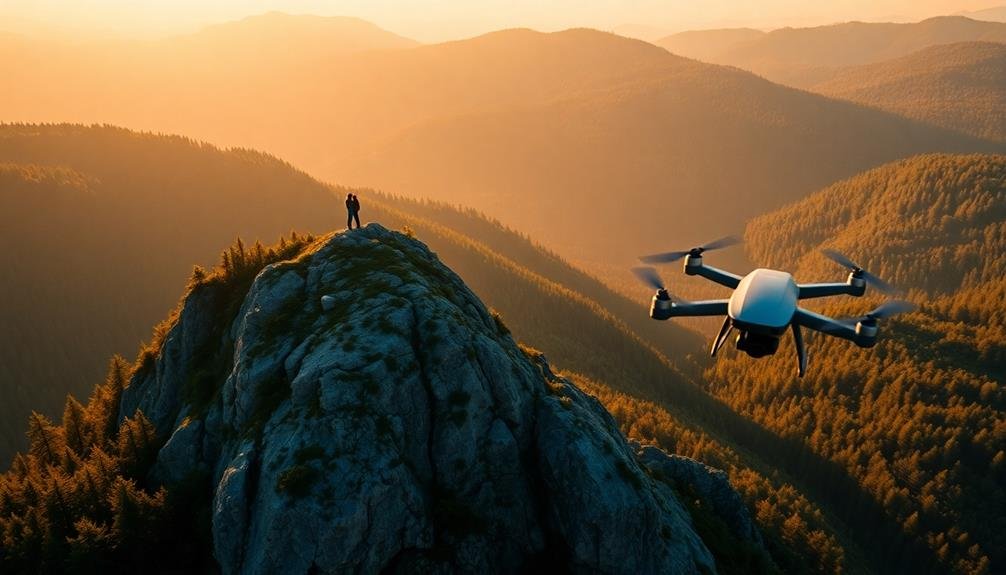
When selecting a drone for elopement photography, consider both your skill level and the specific requirements of the shoot. If you're a beginner, opt for a user-friendly model with automated features like obstacle avoidance and return-to-home functions. For more experienced pilots, advanced drones offer greater control and higher-quality cameras.
Portability is vital for elopement photography, especially in remote locations. Look for compact, foldable drones that are easy to transport.
Battery life is another key factor; choose a drone with at least 25-30 minutes of flight time to capture all the necessary shots without frequent landings.
Camera quality is paramount. Seek drones with at least a 12MP camera and 4K video capabilities. Some high-end models offer interchangeable lenses for greater versatility.
Consider drones with gimbal stabilization to guarantee smooth footage and sharp images.
Weather resistance is essential for outdoor shoots. Select a drone that can handle light wind and moisture.
Mastering Drone Flight Techniques
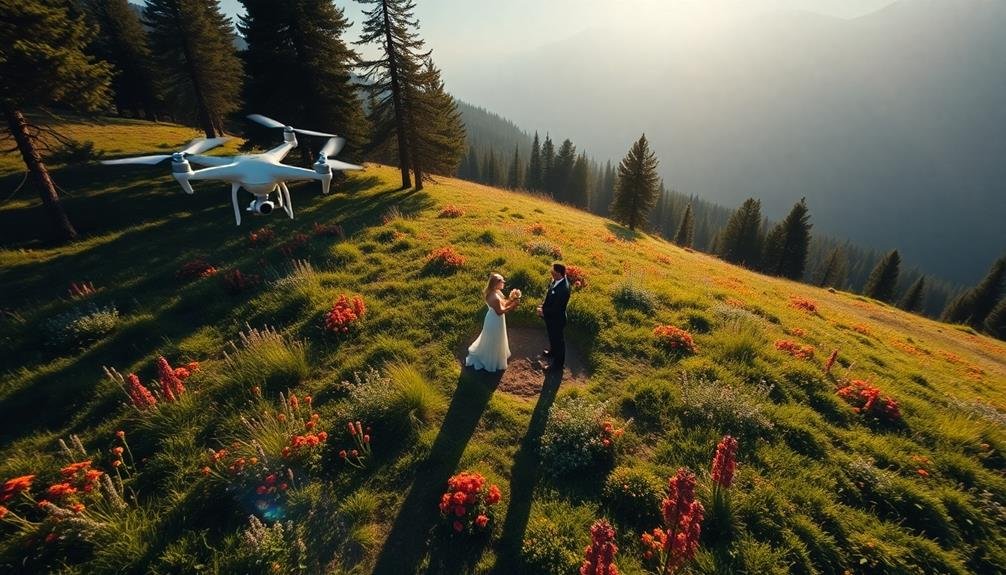
Now that you've chosen the right drone, it's time to hone your flying skills. Start by mastering basic maneuvers in an open area, away from people and obstacles. Practice takeoffs, landings, hovering, and flying in different directions. Focus on smooth, controlled movements to capture steady footage.
Learn to fly in various patterns, such as circles, figure-eights, and straight lines. These techniques will help you create dynamic shots and cinematic movements. Familiarize yourself with your drone's intelligent flight modes, like follow-me, orbit, and waypoints. These features can automate complex flight paths, allowing you to focus on composition.
Practice flying at different altitudes and speeds to understand how they affect your shots. Experiment with various camera angles and movements to add depth and interest to your elopement footage. Always maintain visual line of sight with your drone and be aware of your surroundings.
Lastly, master the art of storytelling through your drone footage. Plan your shots to capture the couple, the landscape, and the overall atmosphere of the elopement. With practice and patience, you'll be able to create stunning aerial footage that adds a unique perspective to the couple's special day.
Scouting Perfect Aerial Locations
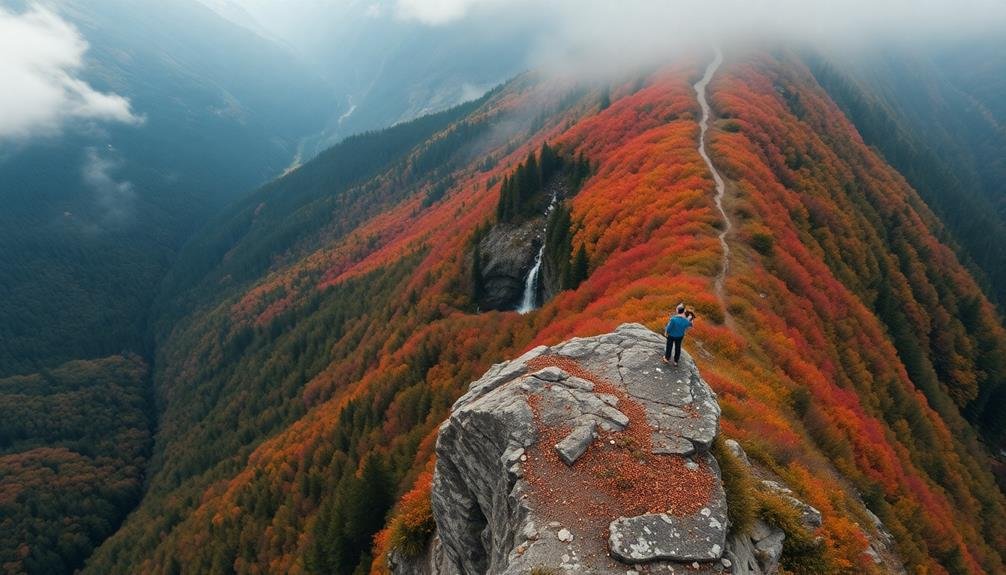
Identifying ideal aerial locations is essential for capturing breathtaking elopement footage. When scouting for perfect aerial spots, you'll need to evaluate several factors.
First, look for areas with stunning natural features like mountains, beaches, or forests that'll provide a picturesque backdrop for the couple. Pay attention to the lighting conditions at different times of day, as golden hour can create magical aerial shots.
Research local regulations and obtain necessary permits for drone flights in your chosen locations. Safety should be your top priority, so avoid areas with heavy air traffic or obstacles that could interfere with your drone. Look for open spaces that allow for unobstructed views and smooth flight paths.
Evaluate the couple's preferences and the overall mood they want to convey in their elopement photos. Scout locations that align with their vision, whether it's a secluded mountain vista or a dramatic coastal cliff.
Use online resources, topographic maps, and satellite imagery to identify potential spots before visiting in person. Once on-site, test different altitudes and angles to find the most compelling compositions.
Remember to respect the environment and leave no trace during your scouting and shooting sessions.
Composition for Breathtaking Elopement Shots

When composing breathtaking elopement shots, you'll need to master the art of framing the perfect shot.
You'll want to position your couple strategically within the frame, using natural elements or architectural features to create visual interest.
Balancing the stunning landscapes with your subjects is essential – you'll aim to showcase the beauty of the location while keeping the focus on the couple's intimate moments.
Framing the Perfect Shot
Artistry in elopement photography hinges on masterful composition. When framing the perfect shot, consider the rule of thirds, leading lines, and symmetry. Place your couple at the intersection points of an imaginary 3×3 grid to create visual interest. Use natural elements like mountain ranges or shorelines as leading lines to draw the eye to your subjects.
For aerial shots, experiment with different angles and heights to capture unique perspectives. Drone photography offers endless possibilities for framing breathtaking elopement moments. Consider these framing techniques:
| Technique | Description | Best For |
|---|---|---|
| Bird's Eye | Directly overhead shot | Showcasing location |
| Angled Descent | Tilted view from above | Dramatic landscapes |
| Low Hover | Close to ground level | Intimate moments |
Remember to balance your composition with negative space, allowing the surrounding environment to complement the couple. Frame your subjects within natural archways or use foreground elements to add depth. Don't be afraid to get creative with unconventional framing, such as shooting through foliage or capturing reflections in water. By mastering these framing techniques, you'll elevate your elopement photography and create stunning, unforgettable images for your clients.
Balancing Landscapes With Subjects
Striking the perfect balance between landscapes and subjects is essential in elopement photography. You'll want to showcase the breathtaking scenery that inspired the couple's choice of location while keeping them as the focal point. To achieve this, consider using the rule of thirds to position your subjects off-center, allowing the landscape to frame them naturally.
Experiment with different perspectives to create depth and dimension. Place the couple in the foreground with a stunning backdrop, or capture them as small figures in a vast, awe-inspiring landscape. Use leading lines in the environment to draw the viewer's eye to the couple.
Pay attention to the interplay of light and shadow. Golden hour can create a warm, romantic atmosphere that enhances both the landscape and your subjects. In challenging lighting conditions, use fill flash to balance exposure between the couple and their surroundings.
Don't forget to capture intimate close-ups as well as wide-angle shots. Alternating between these perspectives will tell a more complete story of the elopement and its setting.
Lighting Considerations for Aerial Photography
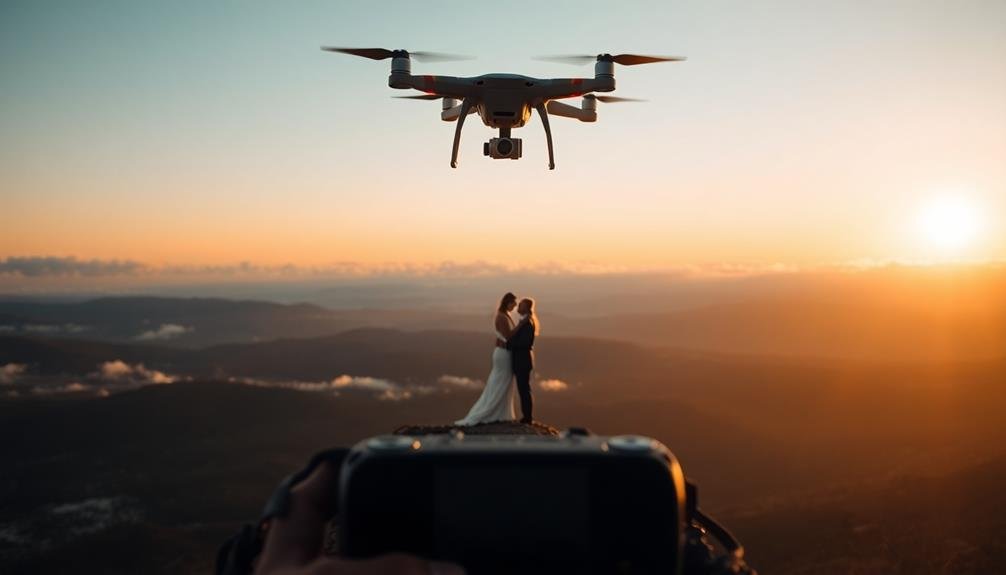
When capturing aerial elopement shots, you'll need to master various lighting conditions.
You'll find magic during the golden hour, with its warm, soft light creating stunning landscapes and silhouettes.
However, you'll face challenges with harsh midday sun, requiring careful exposure adjustments, while nighttime aerial photography demands specialized illumination techniques to showcase the couple against a starlit backdrop.
Golden Hour Magic
The coveted golden hour often provides the most breathtaking conditions for aerial elopement photography. This magical time occurs shortly after sunrise or before sunset when the sun is low on the horizon, casting a warm, golden glow across the landscape. To make the most of this fleeting period, you'll need to plan carefully and be ready to act quickly.
When shooting during golden hour, you'll find that the soft, diffused light minimizes harsh shadows and creates a romantic atmosphere perfect for elopement photos. The warm tones can enhance skin tones and add a dreamy quality to your images.
To capture the best aerial shots, position your drone to take advantage of the long shadows and dramatic lighting. Experiment with backlighting your subjects for an ethereal effect, or use the golden light to illuminate the landscape and create stunning panoramic views.
Remember that the golden hour's duration varies depending on your location and time of year. In some cases, you may only have 20-30 minutes of prime light.
Be prepared by scouting locations in advance, having your equipment ready, and communicating clearly with the couple to guarantee you can maximize this precious time for unforgettable aerial elopement photographs.
Harsh Midday Challenges
Midday's harsh sunlight presents unique challenges for aerial elopement photography. You'll need to adapt your techniques to combat strong shadows, overexposure, and loss of detail. To mitigate these issues, consider using a polarizing filter to reduce glare and enhance colors.
Adjust your camera settings by lowering the ISO and increasing the shutter speed to prevent overexposure. When shooting from above, pay attention to the angle of the sun relative to your drone's position.
Try to position the couple so that the sun is behind or to the side of them, avoiding direct overhead light. This will help create more flattering shadows and prevent squinting. If possible, seek out natural shaded areas or use props like umbrellas to create softer lighting conditions.
Post-processing becomes essential in harsh midday light. You'll likely need to recover highlights, boost shadows, and adjust contrast to achieve a balanced exposure.
Don't be afraid to embrace high-contrast images, as they can create dramatic, eye-catching aerial shots. Remember to shoot in RAW format to give yourself more flexibility in editing.
With practice, you'll master the art of capturing stunning aerial elopement photos even in challenging midday conditions.
Nighttime Illumination Techniques
Capturing stunning aerial elopement photos at night requires specialized illumination techniques. You'll need to master the art of balancing ambient light with artificial sources to create breathtaking images.
Start by familiarizing yourself with your drone's low-light capabilities and ISO settings. Experiment with long exposures to capture the glow of city lights or starry skies, but remember to use a stable platform to avoid blurry shots.
Consider these lighting options for nighttime aerial elopement photography:
- LED light panels attached to your drone
- Ground-based spotlights or floodlights
- Sparklers or fairy lights held by the couple
- Light painting techniques using handheld sources
When using artificial lighting, be mindful of local regulations and obtain necessary permits. Always prioritize safety and avoid blinding your subjects or other aircraft.
To create depth and dimension in your nighttime shots, try using multiple light sources at different angles. This can help highlight the couple and their surroundings while adding a touch of drama to the scene.
Don't be afraid to get creative with colored gels or natural light sources like campfires or moonlight to add unique effects to your aerial elopement photos.
Drone Regulations for Elopement Venues
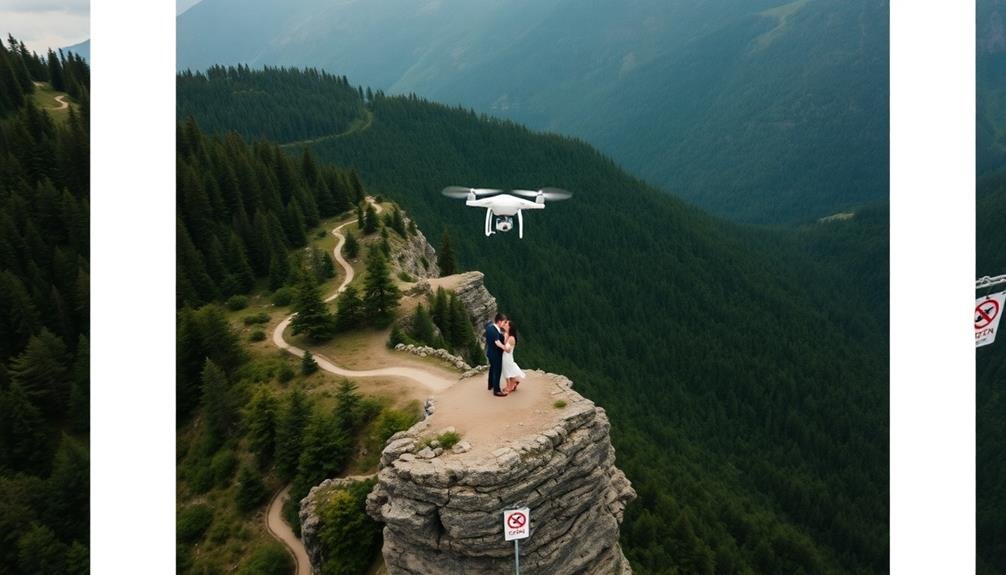
Three key factors determine drone regulations for elopement venues: location, airspace restrictions, and local laws. You'll need to research these aspects before planning any aerial photography for your elopement.
First, check if your venue is on private or public land. Private property requires the owner's permission, while public lands may have specific drone policies. National parks, for instance, generally prohibit drone use.
Next, consult the FAA's airspace map to identify any restricted areas. You can't fly near airports, military bases, or other sensitive locations without proper authorization. Even in unrestricted airspace, you must follow general drone rules, including maintaining visual line of sight and flying below 400 feet.
Local regulations can vary widely. Some cities ban drones entirely, while others require permits. Research your specific location's laws to guarantee compliance.
As a drone operator, you're responsible for safety. Register your drone with the FAA if it weighs over 0.55 pounds, and consider getting a Part 107 license for commercial use.
Always prioritize the safety of people and wildlife in the area.
Editing Aerial Elopement Photos

Once you've captured stunning aerial shots of the elopement, it's time to enhance them through editing. Start by importing your raw files into your preferred editing software. Adjust the exposure, contrast, and white balance to achieve a balanced look.
Pay special attention to the landscape, ensuring it complements the couple without overpowering them.
Next, focus on color grading. Develop a consistent style that matches the mood of the elopement. For outdoor ceremonies, consider enhancing natural tones to create a dreamy, romantic atmosphere.
Don't forget to straighten horizons and correct any distortions caused by the drone's wide-angle lens.
When editing aerial elopement photos, keep these tips in mind:
- Use local adjustments to highlight the couple and key elements
- Experiment with cropping to create dynamic compositions
- Apply subtle vignetting to draw attention to the center of the frame
- Remove any distracting elements, like other people or vehicles
Incorporating Drone Footage Into Highlights
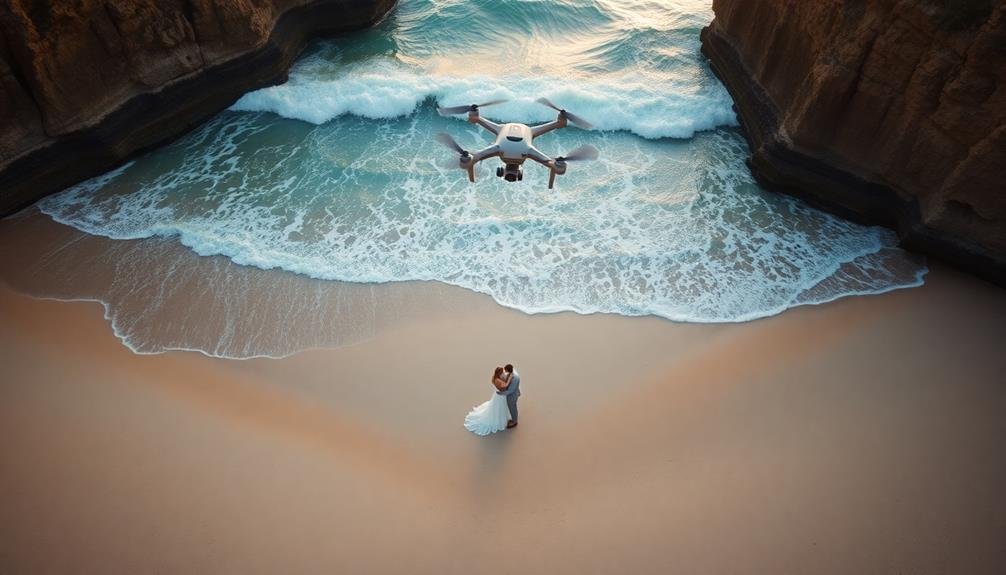
Drone footage can elevate your elopement highlights to new heights, quite literally. When incorporating aerial shots into your highlight reel, focus on seamlessly blending ground-level and aerial perspectives. Start by selecting your best drone clips that showcase the location's grandeur and the couple's intimate moments from above.
To create a cohesive narrative, consider these tips:
| Technique | Purpose | Example |
|---|---|---|
| Establish shots | Set the scene | Wide aerial view of venue |
| Connecting clips | Connect scenes | Zoom from aerial to ground |
| Action sequences | Add dynamism | Follow couple walking |
Use drone footage sparingly to maintain impact. Aim for a 70-30 ratio of ground to aerial shots in your final edit. When editing, match the color grading and style of your drone footage with your ground-level shots for a unified look.
Don't forget about audio! Overlay meaningful sounds like vows or ambient noise to enhance the emotional connection. Finally, experiment with speed ramping and slow motion to create visual interest and emphasize key moments in your aerial footage.
Frequently Asked Questions
How Can I Prevent Drone Noise From Disrupting the Elopement Ceremony?
To prevent drone noise from disrupting the ceremony, you'll want to fly at a higher altitude, use quieter propellers, and maintain distance. Consider operating the drone before or after the vows, or during natural pauses in the event.
What Backup Plans Should I Have if Weather Conditions Prevent Drone Flight?
You'll need alternative plans ready. Consider ground-level photography, using a stabilized camera on a long pole, or finding elevated vantage points. Have indoor location options and be prepared to reschedule if necessary. Always prioritize the couple's experience.
How Do I Communicate With the Couple During Aerial Shots?
You'll need a reliable communication system. Use hand signals, walkie-talkies, or earpieces to guide the couple. Brief them beforehand on your cues. For longer distances, consider having an assistant on the ground relay instructions.
Are There Specific Drone Insurance Requirements for Elopement Photography?
You'll need drone liability insurance for elopement photography. Check local regulations, as requirements vary. Many insurers offer specific policies for commercial drone use. Don't forget to cover your equipment against damage or loss too.
How Can I Incorporate Cultural Sensitivity When Using Drones for Destination Elopements?
When using drones for destination elopements, you'll need to research local customs and regulations. Respect sacred sites, privacy norms, and noise restrictions. Always ask for permission and be mindful of cultural sensitivities in your chosen location.
In Summary
You've now got the tools to capture stunning aerial elopement moments. Remember, practice makes perfect with drone photography. Always prioritize safety and follow regulations. With these skills, you'll create unique, breathtaking memories for couples. Don't forget to blend your aerial shots with ground-level photography for a thorough story. Embrace the challenge, and you'll soon be producing unforgettable elopement albums that stand out from the crowd. Happy flying and shooting!

As educators and advocates for responsible drone use, we’re committed to sharing our knowledge and expertise with aspiring aerial photographers.
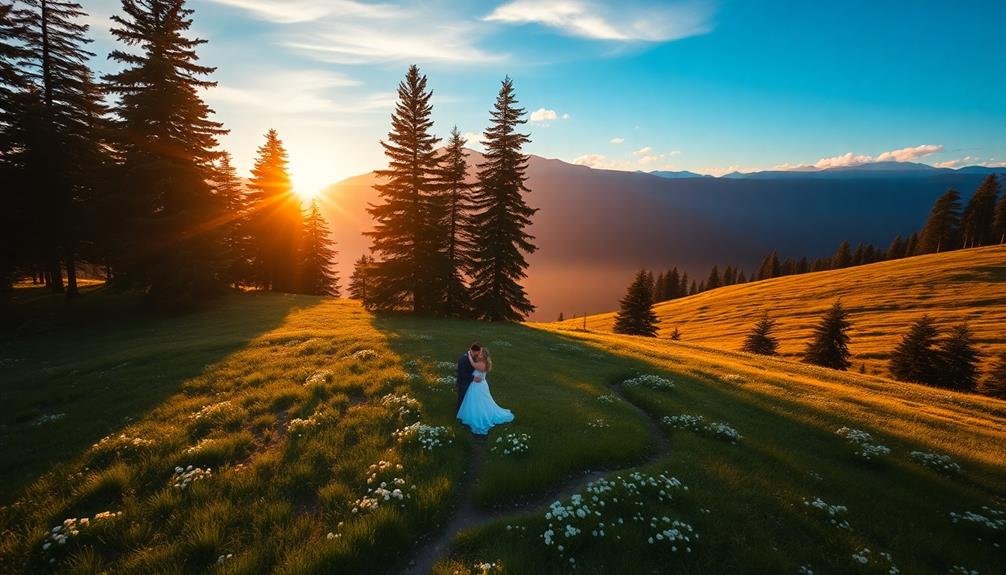



Leave a Reply